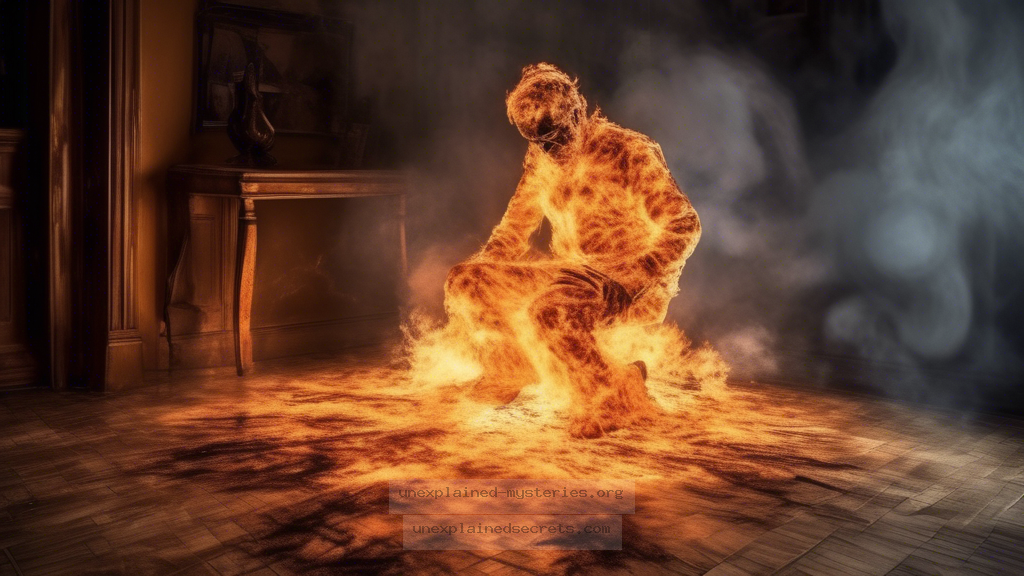What Explains the Mysterious Phenomenon of Spontaneous Human Combustion?
What Explains the Mysterious Phenomenon of Spontaneous Human Combustion?
The enigma of spontaneous human combustion (SHC) has captivated the public and researchers alike for centuries, raising questions about the nature of human anatomy, the boundaries of science, and the potential for paranormal phenomena. This bewildering phenomenon involves individuals reportedly bursting into flames without any apparent external source of ignition. Why does this happen? Is it truly a supernatural event, or are there scientific explanations that have yet to be fully understood? In this blog post, we will delve into the intricate details surrounding spontaneous human combustion, examining historical accounts, scientific theories, and the implications of this mysterious occurrence.
Historical Context of Spontaneous Human Combustion
The concept of spontaneous human combustion has been documented as far back as the 18th century, with one of the earliest reports emerging in 1763 involving a Dutchman named Adalbrecht von Chamisso. Accounts continued to surface, with notable cases such as that of Countess Cornelia Zangari de Rola in 1783 and the infamous case of the “Burning Man” of 1951, whose body was found burned to ashes with little damage to the surrounding environment. These historical accounts serve as a foundation for understanding how the phenomenon has evolved in public consciousness.
Throughout the years, various theories have emerged attempting to explain SHC. Some suggest that it is rooted in folklore, while others propose scientific explanations. The consistency of reports over centuries adds a layer of intrigue, prompting researchers to investigate whether there’s a common thread linking these incidents. 🔍
Core Concepts and Theories Behind SHC
When it comes to spontaneous human combustion, several theories have been proposed to explain how and why it occurs. The most prominent theories include:
- Ketosis: One scientific explanation suggests that a buildup of acetone in the body can lead to a highly flammable state. This is particularly evident in individuals suffering from certain metabolic disorders.
- Wick Effect: This theory posits that a human body can act like a candle wick, where body fat acts as fuel for the fire, and clothing acts as the wick. Once ignited, the person can burn for an extended period, resulting in significant damage.
- External Ignition Sources: Critics of SHC often argue that the phenomenon can be explained by external sources of ignition, such as cigarettes, alcohol, or faulty electrical equipment.
- Paranormal Theories: Some believe that SHC is linked to supernatural forces, such as spirits or curses, leading to the belief that individuals who experience this may have been marked in some way.
Documented Cases of Spontaneous Human Combustion
Several documented cases of SHC stand out due to their peculiar circumstances. One of the most famous is the case of Mary Reeser, a 67-year-old woman found in her home in 1951. The investigation revealed that her body had been almost completely reduced to ashes while the surrounding furniture remained intact. The only recognizable remains were her skull and one foot, leading to widespread speculation about the cause of her death.
Another case involves the death of a man known as “the burning man” in 1986. His body was found in the living room, with minimal damage to the room itself. Investigators noted that while the man’s body was charred beyond recognition, the carpet and nearby objects showed little evidence of fire, a hallmark characteristic of SHC.
Scientific Investigations and Practical Implications
Scientific investigations into SHC have often yielded inconclusive results, leading to a mix of skepticism and intrigue. The lack of definitive evidence makes it difficult to classify SHC as a verifiable phenomenon. However, researchers continue to study cases with a focus on forensic science and human biology. Understanding the chemical processes within the body and how they can lead to combustion remains a pressing area of study.
Laboratories have conducted experiments simulating the wick effect to explore how human fat can act as fuel. These experiments provide valuable insights into the conditions needed for combustion and help to demystify some of the more outlandish claims surrounding SHC.
Alternative Perspectives on SHC
While many skeptics dismiss spontaneous human combustion as a myth, alternative perspectives argue for the need to investigate the unknown. Some researchers advocate for a broader understanding of human biology and the potential for undiscovered phenomena. The idea that there may be more to the human experience than what is currently understood remains a captivating topic in both scientific and paranormal circles.
Additionally, some argue that the phenomenon may be linked to psychological factors, suggesting that extreme emotional states could trigger a physical response leading to combustion. This notion opens the door to exploring the intersection of mental health and physical phenomena.
Common Misconceptions and Clarifications
Despite the sensationalism surrounding spontaneous human combustion, several misconceptions persist. One common myth is that SHC is a common occurrence; in reality, documented cases are extremely rare. Furthermore, many believe that SHC victims are typically found in unusual circumstances. However, investigations often reveal that victims were in normal settings, which adds complexity to the phenomenon.
Another misconception is that SHC victims are always elderly or unhealthy individuals. While some cases do involve older adults, there are instances where younger, seemingly healthy individuals have also been affected. This challenges the narrative that SHC is linked solely to health vulnerabilities.
Best Practices for Investigation and Study of SHC
For those interested in investigating spontaneous human combustion, adhering to best practices is crucial. Here are some recommendations:
- Document Thoroughly: Accurate documentation of cases, including interviews with witnesses and collection of forensic evidence, is essential for future study.
- Collaborate with Experts: Engaging with experts in forensic science, psychology, and anthropology can provide diverse perspectives on the phenomenon.
- Avoid Bias: Approach each case with an open mind, avoiding preconceived notions that might cloud judgment or interpretation.
- Utilize Technology: Employ advanced imaging and analysis technologies to gather data from case sites, which can yield new insights.
Future Developments and Ongoing Research
As the study of spontaneous human combustion continues, ongoing research aims to shed light on unexplained phenomena. New technologies, such as bioinformatics and digital forensics, are being integrated into investigations, allowing researchers to analyze cases in unprecedented ways.
Furthermore, interdisciplinary collaboration between scientists, psychologists, and paranormal researchers is becoming more common. This collaborative effort may lead to breakthroughs that could redefine our understanding of SHC and similar phenomena. The fascination with SHC persists, ensuring that it remains a topic of intrigue and inquiry in both scientific and paranormal realms. 🔮
Conclusion: Embracing the Mystery of Spontaneous Human Combustion
In conclusion, the phenomenon of spontaneous human combustion stands as a compelling intersection between science and the unexplained. While many theories attempt to elucidate the mystery, the reality remains that SHC continues to baffle researchers and enthusiasts alike. The historical context, documented cases, and ongoing investigations all contribute to a rich tapestry of inquiry that invites us to explore the boundaries of our knowledge. As we continue to seek answers, we must remain open to the myriad possibilities that exist beyond the realm of conventional science, embracing the mystery that is spontaneous human combustion. 💭
Other Articles
Recent Posts
- What Happened to Flight MH370? The Conspiracy Theories That Still Haunt Us
- What Secrets Lurk Within the Walls of the Infamous Trans-Allegheny Lunatic Asylum?
- What Evidence Supports the Existence of Bigfoot in the Pacific Northwest?
- What Happened to the Indus Valley Civilization? Unraveling the Mysteries of Ancient Urban Life
- Can Telepathy Be Scientifically Proven Through Laboratory Evidence?







